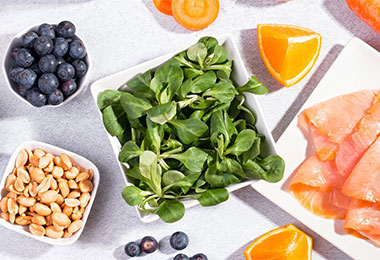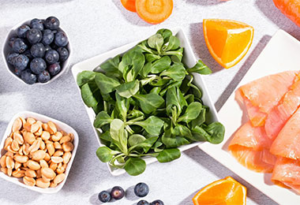ANTI INFLAMMATORY DIET A COMPLETE GUIDE TO EVERYTHING YOU NEED TO KNOW
ANTI INFLAMMATORY DIET A COMPLETE GUIDE TO EVERYTHING YOU NEED TO KNOW

Anti Inflammatory Diet
Chronic, systemic inflammation is a serious health concern that can be made worse — or better — with diet. Here’s what chronic inflammation is, and how what you eat can keep you safer from the chronic diseases inflammation can cause.
What is inflammation?
If you’ve ever cut your finger, bruised a toe or had a throat infection, you have likely experienced at least some of the four signs of inflammation: redness, swelling, pain and heat. Acute inflammation is your body’s natural response to illness, injury or infection and usually resolves on its own.
But there is another kind of inflammation ― the kind that affects the whole body ― which is called systemic. Systemic inflammation can become chronic; it can persist for months, or even years.
Chronic, systemic inflammation is a factor in diseases such as:
Obesity
Metabolic syndrome
Prediabetes
Type 2 diabetes
Heart disease
Inflammatory bowel disease, including Crohn’s disease and ulcerative colitis
Some forms of cancer
Arthritis
Alzheimer’s disease
Inflammatory Foods
What causes inflammation? It can result from exposure to environmental toxins, a lingering virus, aging or chronic stress. But what you eat contributes, too.
What foods cause inflammation? Unfortunately, a lot of them. In particular, experts recommend avoiding these inflammatory foods:
Red meat, such as steak and hamburgers
Processed meat, such as bologna, bacon, sausage and lunchmeat
Commercial baked goods such as snack cakes, pies, cookies and brownies
Bread and pasta made with white flour
Deep fried items such as French fries, fried chicken and donuts
Foods high in added sugar, such as candy, jelly and syrup
Sugar-sweetened beverages such as soda, bottled or canned tea drinks, and sports drinks
Trans fats, found in margarine, microwave popcorn, refrigerated biscuits and dough, and nondairy coffee creamers
Cooking methods can make a difference
When you want to reduce inflammation, baking, steaming or fast stir-frying are preferable to deep frying or grilling.
Cooking meat, especially red meat, on the grill creates compounds associated with cancer. Meat on the grill can drip fat onto the flames and release these compounds, which can end up in the food on your plate. The same is not true of grilled vegetables or low-fat fish, which are safe (and delicious) on the grill.
And don’t feel bad about resorting to the microwave when you’re short on time. Microwaving cooks and heats by activating water molecules, and it is actually healthier than frying or grilling at high heat.
Also, bear in mind that the benefit of healthy items like fish and vegetables can be reversed if you are not careful with sauces and dressings. Many of these condiments and extras are high in inflammatory ingredients such as sugar and trans fat as well as sodium.
Processed Foods: Read the Label
It’s important to check the ingredients list of prepared or processed foods. Many prepared foods contain hidden sugar. It can be hard to tell, since sugar tends to assume aliases: By some estimates, there are over 50 names for added sugar in prepared commercial foods, such as “cane crystals” and “crystalized cane juice,” syrups and many ingredient names that ends in “ose” (chemical shorthand for sugar).
Reading food labels is important. For instance, any food that lists partially hydrogenated oils as an ingredient should be avoided since these are trans fats.
Anti-inflammatory Foods
While there isn’t one specific anti-inflammatory diet, experts say overall healthy eating patterns can help you get rid of inflammation and stay healthier. In particular, they recommend some food types that can help bring inflammation down:
Omega-3 Fatty Acids
One form of these powerful inflammation fighters is found in fatty fish such as salmon, herring, mackerel, sardines, tuna, striped bass and anchovies. You can get the benefit from eating the fish or by taking fish oil supplements.
Vegetarians and vegans have options, too. Another form of omega-3 is plant based. Eating nuts and seeds and cooking with canola oil can supply these nutrients and vitamin E, another inflammation fighter.
Vitamin C
Ascorbic acid, also known as vitamin C, is a powerful antioxidant. Antioxidants help address cellular wear and tear that can set off inflammation.
You’ll find vitamin C in fruits and vegetables, which are the basis of a healthy diet. In addition to well-known vitamin C sources such as citrus fruit and juice, tasty bell peppers are also packed with the vitamin and may yield fewer calories.
check out most related news HOW TO SELL BOOKS ON AMAZON COMPLETE GUIDE FOR 2024
The 40 AMAZON PRODUCTS OUR READERS WERE OBSESSED WITH IN DECEMBER
check out [DOWNLOAD MUSIC] MANXYHOTKING, ALBUM EP -BLOOD
Polyphenols
There is a reason why the Mediterranean diet and other healthy eating plans stress colorful, plant-based foods, whole grains and olive oil.
Polyphenols are naturally occurring compounds in these foods that protect the body from inflammation.
And you can get polyphenol power from your favorite pick-me-up: Coffee, tea and even dark chocolate are rich in these beneficial compounds.
Gut-Healthy Foods
A healthy population of beneficial bacteria (flora) in the intestines can help keep inflammation at bay. To cultivate healthy intestinal flora, enjoy plenty of foods rich in probiotics and prebiotics.
But keep in mind: Not all fermented foods have probiotics. Check the label and ensure that live microorganisms are listed in the ingredients. Yogurt and cottage cheese will have live active cultures noted on the packaging.
Prebiotics, in the form of dietary fiber, are like food for the helpful bacteria. Jerusalem artichokes and foods rich in inulin, such as asparagus, bananas and chicory, help keep the beneficial flora healthy and plentiful.
How to Reduce Inflammation: One Meal at a Time
In terms of well-known diets, the Mediterranean diet may be the most beneficial in helping people get inflammation under control. It emphasizes omega-3s, vitamin C, polyphenols, fiber-rich foods and other known inflammation fighters.
For those who want to start gradually, one strategy is substitution: finding alternatives to foods that cause inflammation. For example:
Instead of… Try:
Charcuterie boards Vegetable slices with hummus
French fries Baked sweet potatoes
Sauces with butter or cheese Olive oil, vinegar and herbs
Grilled burgers Grilled eggplant or portobello mushrooms
Bakery cakes and pies Dark chocolate with raspberries or grilled peaches
Inflammation: You Can Fight It
It can seem challenging at first to eat for lower inflammation with so many inflammatory foods commercially available, but over time, small changes can turn into lasting habits.
While no one food reduces inflammation, building a healthy, holistic dietary pattern can help lower your risk of inflammatory disease and transform your health.
In this attic we will guide you through to show
HOW NUTRITIONALLY BALANCED BREAKFAST CAN GIVE YOUR DAY A HEALTHY START

Healthy Breakfasts
A nutritionally balanced breakfast can give your day a healthy start, help you focus, keep you energized, control your urge to snack and support digestion. Clinical dietitian Regina Shvets of Sibley Memorial Hospital offers healthy breakfast ideas and tips.
What is a healthy breakfast?
A good breakfast is one that supplies plenty of protein, complex carbohydrates and healthy fats. Together, healthy foods energize the body and ensure you can start your day without being distracted by hunger. While whole foods are the ideal, busy people may reach for prepared items for convenience. When including commercial or processed items, reading the nutrition information can help you avoid extra sugar, salt and fat.
Healthy Breakfast Foods
It helps to remember that any healthy food can work for breakfast, so go ahead and think outside the cereal box. Lean protein in the form of beans, fish or chicken breast can make its way onto your breakfast plate. Fresh veggies can add fiber, vitamins and minerals to omelets or smoothies.
Protein
According to Shvets, protein should be the main focus of the day’s first meal, with additions of whole grains, fruits and vegetables, and good fats.
“Protein is important because it is made up of individual molecules of amino acids that serve many essential functions in the body. Some of its functions include making hormones, providing energy, building and repairing muscle, supporting the immune system, and maintaining the structure of hair, nails and skin.
“Some amino acids can be produced by the body on its own, but there are nine amino acids that are considered to be essential and can only be obtained from eating certain foods.
“Foods high in protein are good for weight control since they are very filling. When you stay full longer, it’s easier to resist snacking,” Shvets says.
Protein in Eggs
One large egg contains about 6.2 grams of protein, according to the U.S. Department of Agriculture’s food database.
Are eggs good for you? Yes, says Shvets. “Eggs are super nutritious. They are one of the best sources of high-quality protein and contain all the essential amino acids that cannot be produced on our own.
“Older published studies suggested that eggs were harmful to heart health due to a high content of cholesterol in them. However, newer evidence has proved that eating eggs offers more benefits to health than harm. Both egg whites and egg yolks contain high amounts of vitamins A, D and B, as well as nutrients such as zeaxanthin, choline and selenium and a healthy fatty acid called linoleic acid.”
She adds, “Research shows eating two eggs per day meets 10% to 30% of the vitamin requirements for adults. These qualities in eggs are associated with positive health outcomes for people in all age groups. Egg protein can support skeletal muscle growth, prevent loss of muscle mass and promote normal growth in children.
“People without a history of high cholesterol may eat one or two eggs every day if they like. Those with high cholesterol may eat one whole egg and two egg whites a few times per week.”
Yogurt
Yogurt is packed with protein and probiotics (gut-healthy bacteria) and can be a great foundation for breakfast. But, choosing an option for breakfast can be a challenge, with dozens of brands, formulas, flavors and varieties on the grocery store shelves.
Shvets advises careful reading of yogurt ingredients. “Some yogurts are so high in added sugar, including chocolate chips, cookie pieces and candies, that they’re really more like a dessert. Yogurts with less than 10 grams of sugar per serving would be more healthful,” she says, noting current dietary guidelines recommend that Americans limit their calories from added sugars to less than 10% of total calories.
Healthy Breakfast Meats
“Typical breakfast meats, such as sausages, bacon and ham, are heavily processed and are associated with adverse health outcomes,” Shvets warns. “Many are loaded with preservatives to make them shelf stable, as well as sodium, nitrosamines and synthetic food dyes. They can also be high in saturated fats. It’s best to eat these breakfast meats occasionally and in small amounts.
“Other, low-sodium sources of lean protein such as chicken breast, turkey or even roast beef [not processed deli/lunchmeat versions, which are high in sodium] could be a healthier alternative,” she says.
Other Sources of Breakfast Protein
Shvets also recommends:
Low-fat dairy milk
Fortified soy milk
Cottage cheese
Nuts and nut butters
Chia seeds, flax seeds or butters made from these
Beans and legumes
Whole Grains
Shvets says a good breakfast includes whole grains. “These could be minimally processed hot cereal or breads made with intact grain kernels. Whole grains include the kernel’s bran, endosperm and germ, which contain B complex and other vitamins, some protein and fiber,” she explains.
She recommends limiting white bread and plain bagels, which are made with wheat that has had the outer part of the kernel removed during processing and lack important nutrients, such as fiber and B-complex vitamins.
Healthy Cereal
A bowl of cereal is a staple of American breakfasts. Shvets says good whole grain hot cereals include old-fashioned oats, steel cut oats, buckwheat, whole grain cornmeal and quinoa.
However, commercial boxed cereals, a favorite among children, warrant a careful reading of their ingredients list and nutritional value, says Shvets.
“A healthy cereal is one that is minimally processed and is not full of added sugars, food dyes, preservatives and other components that could negatively affect health,” she says. “Look for cereal that has the fewest ingredients and with the first being 100% whole grain. Avoid those with more than 5 grams of sugar per serving.
“Hot or cold, remember to pair your cereal with milk, Greek yogurt, fruit, nuts or seeds for an additional boost of protein, vitamins and other healthful ingredients.”
Healthy Fats
Fats add flavor and appeal to foods, and breakfast choices are no exception. Shvets advises incorporating healthy fats at breakfast for increased energy, improved heart health and blood sugar control. Her suggestions:
Avocado
Nuts such as walnuts, almonds and pecans
Seeds such as pumpkin or sunflower
Butters made from healthy nuts and seeds
Smoked salmon
Fruits and Vegetables
Related news SOLOCVIBEZ BIOGRAPHY REAL NAME STATE OF ORIGIN AND NET WORTH
check out VICTONY STUBBORN FT ASAKE
Here is 10 GREAT REASONS TO STUDY ABROAD IN ITALY
“And of course, we should not forget about fruits and vegetables,” says Shvets. “According to current dietary guidelines for Americans, adults should consume 1½ to 2 cups of fruits and two to three servings of vegetables every day, but that’s not a tall order when you remember that one serving is a small amount. For example, a medium apple or 1 cup of strawberries is one serving. Many people do not get the recommended daily amounts of fruit and vegetables, so adding a cup of fruit or vegetables to your breakfast will help meet that goal.”
For example, she notes, berries, mangoes, apples, pineapples, spinach, kale and celery can add color and flavor to your breakfast plate or blend easily into a smoothie to take with you on the go.
Why is breakfast so important?
“Breakfast offers numerous benefits to people in all life stages, and it can also help with meeting certain health goals,” Shvets says. For instance:
School-age children need healthful nutrients, including a good breakfast, for growth and development as well as academic success.
Working adults benefit from a good breakfast that can help them stay focused, energized and productive during morning hours and meetings.
Older adults who are frail and are losing weight unintentionally will greatly benefit from eating breakfast, as adequate nutrition could promote increased muscle strength and agility in this age group.
For people trying to reach or maintain a healthy weight, a balanced breakfast could help by preventing hunger, which could lead to overeating and excessive calorie intake later in the day.
Breakfast can support stable blood glucose levels for people who have insulin sensitivity.
Including whole grains and fresh fruit and vegetables with breakfast supplies fiber, which supports gut health and can prevent or ease constipation.
Healthy Breakfast Ideas
The principles of the Mediterranean diet can be applied for healthy breakfasts as well as other meals. The Mediterranean diet is not a fad. It’s an approach to eating that emphasizes:
Plant-based foods such as fruits, vegetables, whole grains, beans, nuts and seeds
Olive oil and seasoning with herbs and spices instead of saturated fat and sodium
Protein from fish, eggs, beans, legumes and poultry instead of red meat
Reduced refined carbohydrates such as white flour and added sugar
Shvets points out, “The Mediterranean diet is one of the healthiest eating patterns, and has been associated with reduced risk of chronic disease and increased longevity.”
Try these Mediterranean diet-inspired breakfast options for a great start to any day:
Greek yogurt with honey and walnuts
Whole-wheat toast with sliced avocado and smoked salmon
Pancakes with grated zucchini
An omelet with vegetables such as spinach, tomato and mushroom slices
Cottage cheese with berries
Overnight oats with chia seeds, honey and fruit
Breakfast smoothie with milk, yogurt, fresh fruit and spinach
Whole-wheat crepes with fresh fruit and a dash of honey
Easy Zucchini Pancakes
Ingredients:
2 medium zucchinis
3 tablespoons olive oil
2 eggs
Salt and pepper to taste
Fresh herbs: 4 sprigs of fresh parsley or dill OR dry herbs: 1 teaspoon
1 cup all-purpose flour
Sour cream or plain Greek yogurt
Directions:
Grate zucchini using the larger holes of the grater. Put grated zucchini in a colander over a sink for 10 to 15 minutes to let the liquid drain. Squeeze out remaining liquid.
Heat oil in a large skillet over medium heat.
In a large bowl, whisk eggs, salt and pepper, and herbs. Add flour and mix.
Drop 1/4–cup portions of zucchini mixture on the heated skillet and spread it out into round pancakes, leaving space in between.
Fry until golden brown and flip as needed, about 3 to 4 minutes on each side.
Serve warm with sour cream or plain Greek yogurt.
Nutrition information per one 4-inch pancake without sour cream or yogurt:
93 kcals, 10 grams carbohydrate, 5 grams fat, 3 grams protein.
Crepes
Ingredients:
3 eggs
1 teaspoon salt
1 to 2 tablespoons sugar
16 ounces milk, divided
2 cups whole wheat flour
3 tablespoons olive oil or avocado oil (plus more for cooking)
½ cup boiling hot water
Directions:
Whisk eggs and salt in a large mixing bowl. Add 1 to 2 tablespoons of sugar to taste.
Slowly add 1 cup of milk. Mix with the whisk or a fork.
Sift the flour, and mix it into the egg mixture.
Slowly add the remaining milk to the egg mixture.
Add hot water. Mix in the oil, and allow the batter to stand for 15 to 20 minutes.
Heat a few drops of oil in a small or medium skillet over medium heat.
Using a ladle, pour ½ cup batter (may need to use more batter, depending on the size of skillet) in the center of the hot skillet, and quickly spread it out all over the skillet in a thin layer. Tilt the skillet in a circular motion to ensure that the batter is spread out evenly.
When bubbles start forming on top of the crepe and the edges start turning brown, carefully flip it on the other side using a wide spatula. Allow the crepe to turn golden brown on both sides, then transfer to a large plate.
Serve with honey, fresh fruit or yogurt.
Nutrition information per 9-inch crepe: 115 calories, 14 grams carbohydrates, 4 grams protein, 5 grams fat.
GET ALL LATEST NAIJA NEWS VIDEOS COMEDIES BIOGRAPHY DJ MIXTAPE AND MANY MORE TODAY
MOST TRENDING MUSIC
KAESTYLE DEALER LYRICS FT OMAH LAY
2SLIZ ASSIGNMENT FT G I G GANGZ
9JAHITSONGS IS ONE OF THE BEST NIGERIA DELIVERY ENTERTAINMENT WEBSITE THAT DELIVERED ALL LATEST NIGERIA NEWS AND CELEBRITIES GIST
PROMOTE YOUR MUSIC VIDEOS COMEDIES NEWS DJ MIXTAPE BIOGRAPHY AND MANY MORE WITH US TODAY
Do you find 9jahitsongs useful? Click here to give us five stars rating!






















![[DOWNLOAD MUSIC]TERRI SNTANA-NACIDO DE NUEVO FT GIG GANGZ_ BORN AGAIN_ MP3](https://9jahitsongs.com/wp-content/uploads/2023/10/A50526EA-43C9-42A5-A8DD-8F554909604E.jpeg)
![[STREAM DOWNLOAD MUSIC ]JAH SPIDER-NHERERA_ MP3 / MORARI ALBUM](https://9jahitsongs.com/wp-content/uploads/2023/10/41C73EA6-8C57-49D6-B712-DF278056306B.jpeg)